Flight restriction impacts physical health.
As I said in my “Built for Flight” section, parrots do a lot of flying in the wild. If we prevent them from flying or greatly limit their flight through wing clipping/wing trimming, insidious health issues can arise. A bird who doesn’t fly makes precious little use of its flight muscles–the flight muscles that are supposed to account for 25-35% of its total body mass.1 And what happens to muscles when they aren’t used? They atrophy, or waste away. One study compared the pectoralis muscle strength of birds before and after forty days of total flight restriction. The results showed that pectoralis muscle strength had decreased significantly in those forty days.2
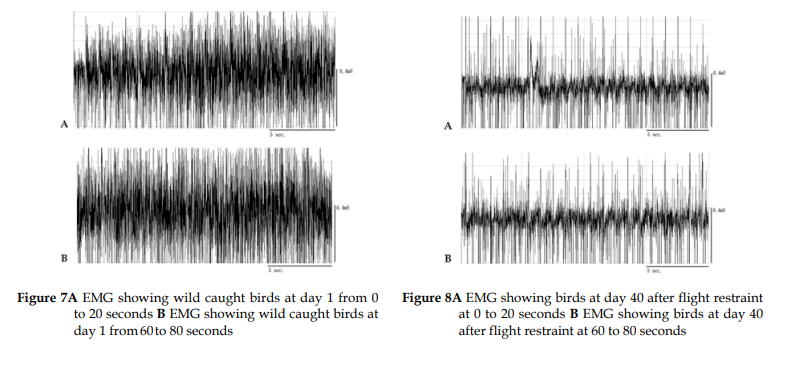
These images show the electrical activity of birds’ pectoralis muscles before and after forty days of flight restraint. The marked change in strength is apparent. (Source: see footnote 2.)
Muscle atrophy is caused when an inappropriately low mechanical load is placed upon a muscle. This can be due to the reduced gravity of space flight, bed rest, immobilisation, or disuse.3 Muscle loss also occurs as a natural part of aging, but physical activity helps prevent this.4 Those perch-bound birds you may seen have atrophied flight muscles. It can take months or even years to rehabilitate a previously clipped bird, depending upon the severity of the clip and how long it was clipped for. Sometimes, they never truly regain correct posture or control while flying. Research in both mice and humans has shown that it gets harder to recover from muscle atrophy as an animal gets older.5
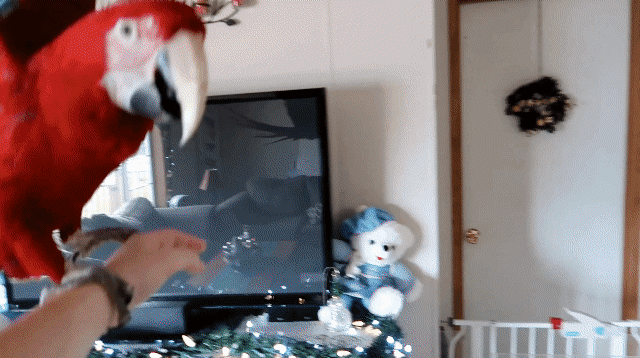
This greenwing macaw was clipped before fledging and remained clipped for the first 21 years of his life. It took him about 2.5 years to grow all of his flight feathers back once he went to a new home and stopped being clipped. He never voluntarily flapped his wings. At 24 years old, his new owner began running in the house with him to encourage flapping. In this video, he aims for his cage and his owner lets him go. Sadly, his muscles are so weak from disuse that in the space of a few feet he loses almost all of his height. After practising encouraged flapping for about eight months, this macaw started voluntarily flapping. He has yet to attempt any flight on his own, even to earn treats during target or recall training. His owner is going to try with even shorter distances and hopes to get him flying eventually. Credit: 1Tale4Paws on Youtube and Instagram.
Bone health can also be affected by lack of exercise. Dr. Scott Echols, avian veterinarian, has observed trends in bone disease among his patients. He found that physical inactivity plays a role in decreased bone density and recommends that pet birds perform bone-loading activities such as flying, climbing, and walking. All three activities contribute to bone health; birds who don’t fly tend to have weaker bones in certain areas of their bodies.6 His observations make sense, of course, because bone disuse leads to bone loss.7 A clipped bird does not often use its wings; using them in a weight-bearing capacity is even rarer. While there are partial wing clips which allow birds to achieve some flight ability, these still have visible effects on a bird’s posture. Whether this posture may, over the course of years, affect their spine and cause discomfort has not been studied, but it is certainly something to consider. What if a human were to constantly walk stooped over due to a heavy burden placed upon their back? That person might be “working harder”, but the burden would force them into an unnatural posture and almost certainly cause pain, if not more serious orthopedic issues. It seems logical to assume that maintaining a correct and natural posture while flying would be more comfortable and healthier for a bird in the long-term.
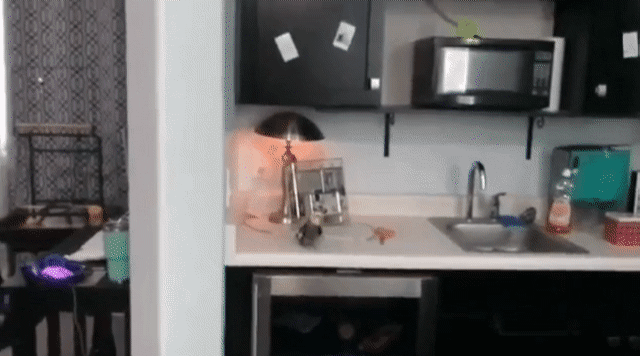
This cockatiel demonstrates the impaired posture of a bird who is clipped but retains some flight ability. Because he is struggling to generate enough lift to keep his body airborne, his back end droops and gyrates in a front to back motion. A parrot with unaltered wings carries its body parallel to the ground and does not struggle to keep its back end level with its head. Credit: Alicia K.
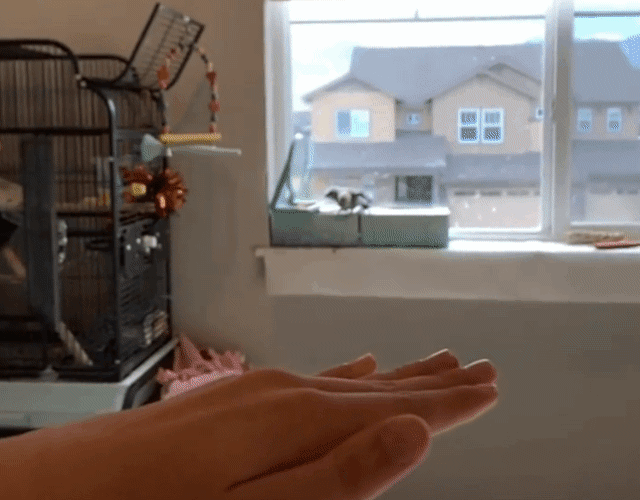
If observing this cockatiel and the previous one at full speed, someone inexperienced with parrot flight might think that both birds are flying in more or less the same way. In slow motion, however, there is a clear difference between the two. The second bird, of course, is fully flighted and exhibits natural posture and control. Credit: @_ruby_the_cockatiel_ on Instagram.
Heart disease is incredibly common in pet parrots. A study performed on 107 deceased captive parrots found that 36% of them had visible gross lesions of the heart or major vessels, while 99% of them had low-grade abnormal changes to the heart or major vessels. 49% had an accumulation of fat cells in their cardiac muscle.8 In an earlier study on 269 deceased captive parrots, 10% had visible evidence of heart disease, and congestive heart failure was the probable cause of death for 6% .9 Research on zoo birds revealed that 90% had fatty streaks and fibrous plaques in their arteries, while 24% had lesions associated with atherosclerosis (hardening and narrowing of the arteries).10 This study points out that “parrots usually do not show clinical signs of atherosclerosis, and the most common sign is believed to be sudden death”. Yet another study on zoo birds found that small birds, such as finches, sparrows, doves, and parakeets, had a much lower incidence of hardened arteries; these birds were kept in enclosures that allowed them to maintain a high level of physical activity. Hardened arteries were seen more commonly in larger birds which the authors note had little opportunity for natural activity and behaviour, such as ducks, geese, macaws, cockatoos, hawks, eagles, and storks.11
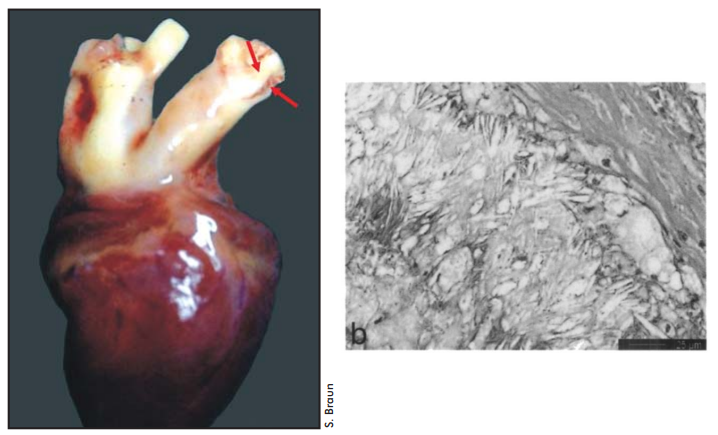
Left: Arrows point to thickening and discoloration on the heart of a deceased African grey with arteriosclerosis. Image from Clinical Avian Medicine. (See footnote 13.) Right: Atherosclerosis in a budgerigar’s aortic wall as seen under a microscope (x100 magnification). In this study, seven birds without any visible heart abnormalities were found to have atherosclerosis upon microscopic examination. The authors write, “These findings emphasize that the diagnosis of atherosclerosis cannot be based solely on macroscopic findings”. (Source: see footnote 8.) Thus, the heart may look healthy even while fatty buildup and other harmful changes occur.
The main risk factors associated with heart disease in captive birds are, according to researchers and avian veterinarians, “Lack of exercise, obesity, and nutritional deficiencies”. (Source: see footnote 8.) “Inactivity and social stress caused by the inability to exhibit natural behavior…” (Source: see footnote 10.) “Lack of exercise, inappropriate diet, and abnormal environments”.12 A comprehensive text on avian cardiology written by four veterinarians states that “Proper flight exercise and diet will prevent obesity, a major contributor to this cardiac disease [atherosclerosis]”.13 Obesity increases risk of developing not only heart disease, but a myriad of health issues, including fatty liver disease 14, 15, 16, kidney disease17, diabetes18, hypertension19, osteoarthritis20, difficulty breathing due to air sac compression21, foot lesions22, and egg-binding23, among others. (See footnote 14 for a veterinary source which lists each of these health risks associated with obesity.) Nutrition is surely a concern when it comes to preventing heart issues and obesity, but why would we make it harder on our birds to be healthy by not allowing them to exercise in a way that is most natural for their bodies?
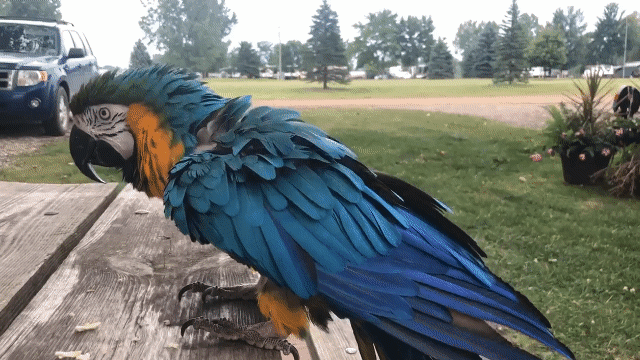
This blue and gold macaw is 29 years old and has never flown, having likely experienced flight restriction before fledging. She began plucking when she was 19. Her owner has tried some flapping exercises with her, but they unfortunately cause so much discomfort (most likely due to the pain felt by using muscles she has not used in decades) that she plucks her shoulders after energetic flapping. Birds with this much atrophy can require gentle wing-stretching exercises before progressing to flapping. Her inability to properly flap has been a source of great sadness for her owner, who bought her when she (the bird) was 14. Having learned in recent years about the importance of flight and the effects of wing clipping/wing trimming, she hopes to rehabilitate all of her birds to a lifestyle that includes at least some flight. As seen in the video, this bird has recently started attempting some light flapping. NOTE: DO NOT TAKE YOUR BIRD OUTDOORS UNRESTRAINED, CLIPPED OR NOT. THIS VIDEO IS FOR ILLUSTRATIVE PURPOSES ONLY. Credit: 1Tale4Paws on Youtube and Instagram.
You may have heard the argument that getting a bird to flap its wings is “enough exercise”, but flapping wings rather than flying is not a sufficient mechanical load for an animal which naturally relies on flight to get around. Take a look at the image below this paragraph and note the difference in aerobic exercise a bird experiences when it flies compared to when it walks.24 Even while vigorously flap-running at a steep angle, a bird uses less than half the energy it does during level flight. Compare more modest flap-running to ascending flight and the bird uses only 10% as much energy.25 Non-flighted locomotion in a flighted bird is an energy-saving strategy, not a way to get a workout. A clipped bird flapping its wings is not truly exercising, even if it is panting and seems tired afterward. In fact, this is indicative of poor physical fitness, similar to a human who becomes worn out after walking from the store to their parked car. Exercise is healthy for so many reasons, even beyond the ones I’ve already mentioned. It enhances immune system competency26, induces brain plasticity27, and helps alleviate depression and anxiety.28
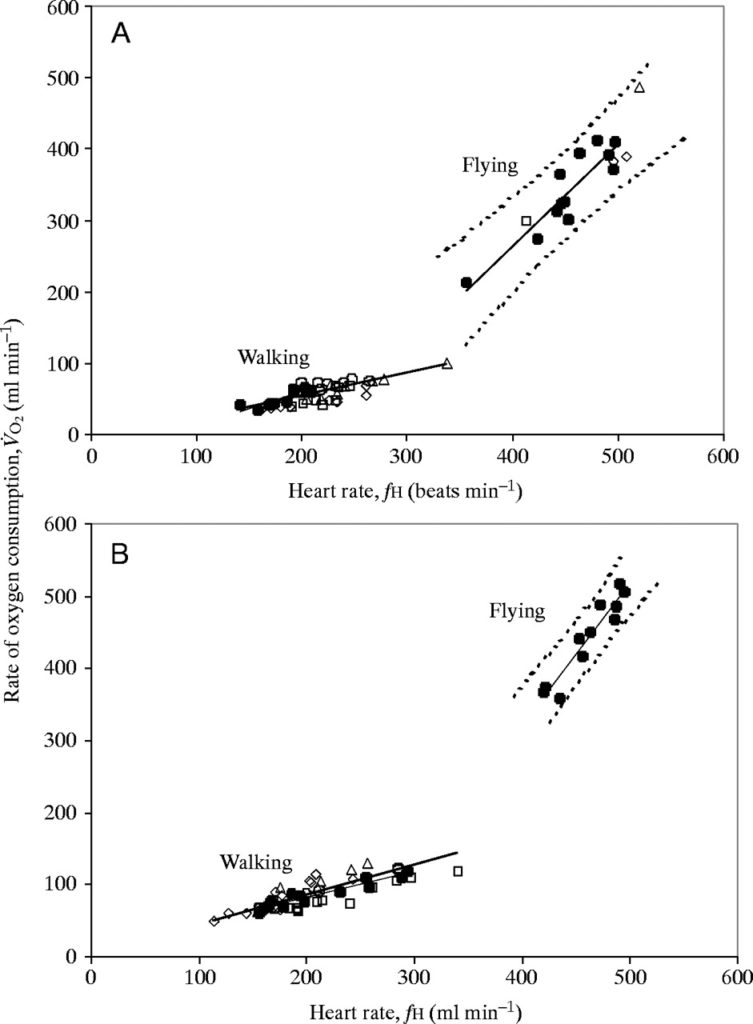
Compare heart rate and oxygen consumption when a bird walks to when a bird flies. It is clear which provides more of a cardio workout. (Source: see footnote 24.) This study was done on geese, who are arguably better at and more suited for walking than parrots. If this study were done on parrots, I believe the disparity would be even greater.
Furthermore, studies on budgies have shown that daily flighted exercise is important for the proper function of a bird’s defences against oxidative stress. Highly reactive atoms, called free radicals, cause damage to living cells. They are byproducts of normal cellular function, but they can also enter the body through pollution, radiation, and certain drugs. In order for an animal’s body to combat these free radicals, it needs antioxidants. Some antioxidants come from diet, but others are produced within the animal’s own body. When the damage overcomes the body’s defences, disease processes occur. Many age-related diseases are associated with oxidative stress. In fact, oxidative stress is now considered one of the main causes of aging, and it interferes with the immune system in harmful ways.29 The budgies in these studies who performed flighted exercise daily for nine weeks had less oxidative stress than the budgies who were mostly sedentary and then performed a single bout of exercise. There was quite a difference in oxidative stress between the birds who had only been flying daily for a week and the birds who had been flying daily for over two months.30 Budgies who were more active in their small cages—walking, climbing, hopping, performing the little flight they could–actually had more oxidative damage than the budgies in small cages who were less active.31
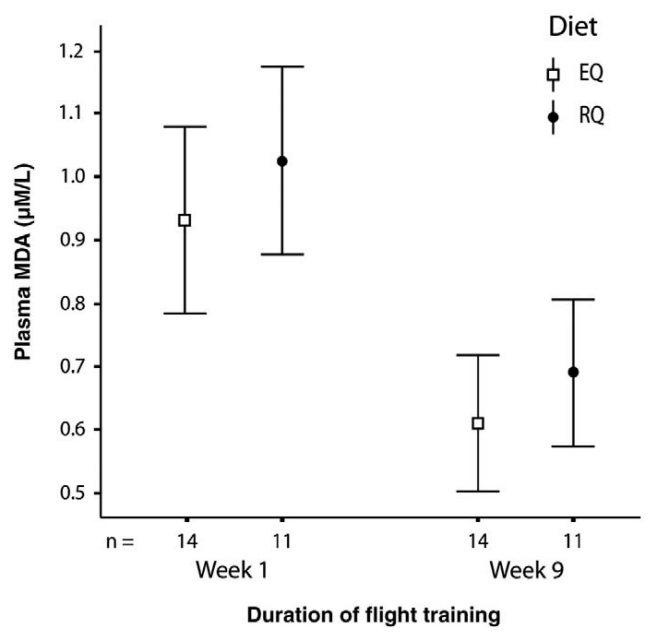
In this budgie study, MDA levels were used as an index of oxidative damage. Oxidative damage decreased with daily flighted exercise training. (Source: see footnote 30.)
This may seem confusing at first. Didn’t I say that exercise protects rather than harms? Exercise itself generates free radicals even while it produces antioxidants and conditions the body to deal with oxidative challenges. “Therefore, excessive physical exercise is detrimental to untrained individuals, but progressive training allows the cells to more easily detoxify a larger amount of ROS [type of free radical].”32 The walking, climbing, hopping, flapping, and even short flights failed to protect against, and only caused the birds more, oxidative stress because the exercise they were performing was not sufficient for their bodies to respond appropriately. The authors of these budgie studies recognise this and suggest that even cages that allow for short flights and the stretching of wings may not be enough to allow birds to obtain the benefits of exercise-mediated antioxidant systems. (Source: see footnote 31). If short flights weren’t enough, how could no flight at all be enough? When someone attempts to exercise their clipped bird by making it flap and then places it back on a perch, their intention may be to improve the bird’s cardiovascular health but, according to these studies, they may actually be causing higher levels of oxidative stress in the process. This is not to say that a clipped bird should be allowed to let its breast and wing muscles fall into complete disuse, but it does underline the importance of allowing birds to exercise the way nature intends them to.
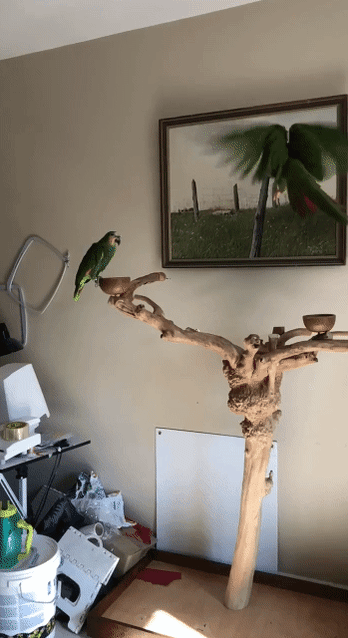
Some may argue that the birds clipped for 20+ years are extreme examples. This bird was clipped for about four years and is now six. Though he has regained flight ability, the effects that flight restriction has had on him are apparent. In this video, he is clearly aiming for the perch, but controlling his direction is difficult; notice how he enters the frame facing left, faces right briefly, then faces left again, all while his body’s orientation remains static. Credit: @bird_tails on Instagram and TikTok.
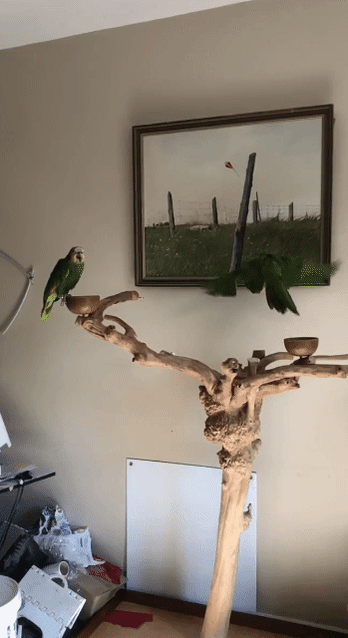
In this part of the video, we can see the difficulty he has with landing; he wavers as he approaches the perch, trying to coordinate the movement of his wings with the position of his feet. He clutches at the perch and falls forward in what amounts to a very clumsy landing. It is simply not realistic to compare the kind of flight this bird is capable of with that of a healthy flyer who has never been clipped. Credit: @bird_tails on Instagram and TikTok.
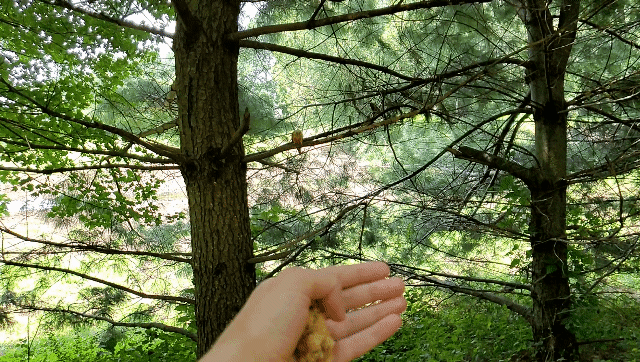
This conure has never been clipped. The fluidity, control, and confidence with which this bird flies presents a stark contrast to the laboured and clumsy fluttering of the conure shown in the two images above. Only after observing clipped birds, birds recovering from flight restriction, and fully flighted birds can one truly appreciate just how incorrect it is to equate flight ability with flight proficiency. (DO NOT TRY THIS AT HOME. THIS VIDEO IS FOR ILLUSTRATIVE PURPOSES ONLY.)
Remember, the length of a bird’s wing bones scales more steeply with weight than the length of their leg bones because their wings are meant to support flight.33 By contrast, humans have relatively long legs and short arms to allow for efficient bipedal locomotion.34 Our parrots still use their legs, but their bodies are not adapted for predominantly leg-based locomotion or their anatomy would reflect it, the way the kakapo’s does. Dr. Kenneth Welle, avian veterinarian, states that “It’s very clear from seeing the aging population of pet birds, that exercise is something that most birds lack. While there are certainly other exercises that parrots can engage in, flight is the most natural and vigorous. Exercise allows and helps maintain cardiac, vascular, muscular, and mental health.”35
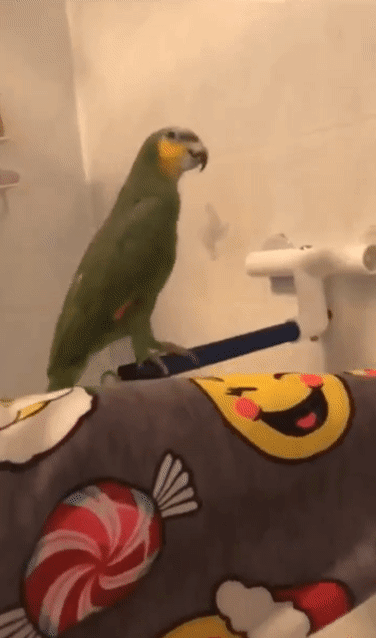
This amazon was clipped shortly after fledging and remained clipped, sometimes lightly, sometimes heavily–her owners used wing trimming to try and control her unwanted behaviour–for the next ten years. Her new owner took her to an avian vet, who diagnosed her with muscle atrophy. This bird had difficulty even opening and closing her wings. With the vet’s guidance, her owner performed daily wing stretches which gradually allowed her to regain the ability to use her muscles. These stretches proceeded centimetre by centimetre and had to take place while the bird was towelled. Credit: @bird_tails on Instagram and TikTok.
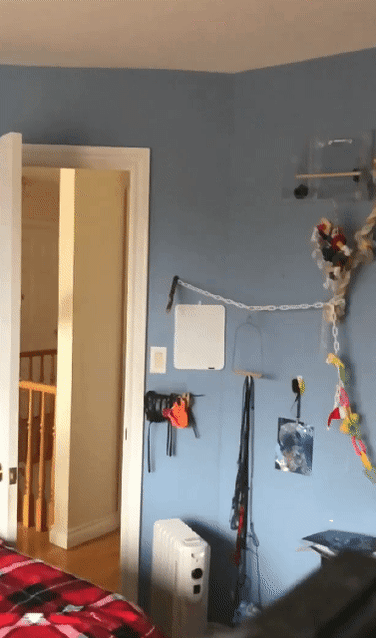
After a year of these daily stretches, she finally began to open her wings on her own. With some practice, she was able to make her first hops and very short flights during recall training (see the video at left). This video at centre shows her making more progress with flight. At this stage, she was unable to maintain the natural posture associated with level flight (body parallel to the ground) and instead carried herself in an upright position at all times. Credit: @bird_tails on Instagram and TikTok.
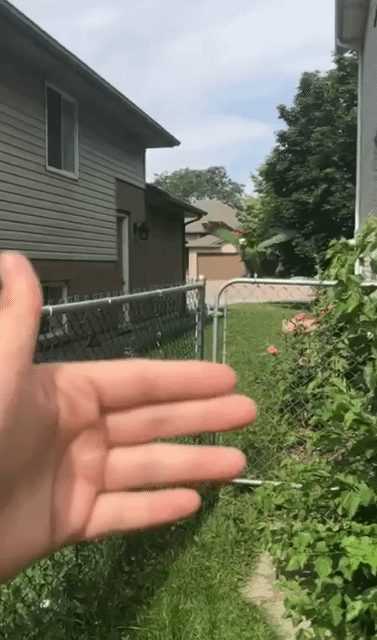
After two years and nine months of rehabilitation, her muscle atrophy has been corrected and her owner, who is experienced in falconry and parrot free flight, has even begun outdoor recall training. (DO NOT TRY THIS AT HOME. THIS VIDEO IS FOR ILLUSTRATIVE PURPOSES ONLY.) Despite vastly improved posture, strength, and coordination, her owner still sees psychological remnants of this bird’s previous disability in the form of reluctance and hesitation. Though she is now physically capable of flight, she still sometimes behaves as though she is unsure whether she can fly. Credit: @bird_tails on Instagram and TikTok.
The last physical effect I’m going to mention is injury, which is not caused by the absence of flight, but rather the attempt to fly with severely clipped wings. An extensive or one-sided wing clip causes a bird to crash to the ground without any control, exposing it to the risk of traumatic injury, particularly of the keel area.36 Even veterinarians who still recommend partial wing clips now frequently acknowledge this risk and denounce severe and one-sided wing clips as “incorrect”.37, 38 Any wing clip, however, increases the risk of broken “blood feathers”, new feathers growing in to take the place of old ones. Because clipped feathers are shortened, they do not cover the delicate, blood-filled shafts of the new feathers, offering inadequate protection and support.39 Without the old feathers present, blood feathers absorb the forces which would ordinarily be distributed between several full-length, full-grown feathers. If a bird so much as knocks a clipped wing against the bars of its cage too hard, this can lead to a blood feather breaking and bleeding. Posts on bird groups complaining of broken blood feathers are almost always about clipped birds. (I have, in fact, never seen one NOT about a clipped bird, though it is theoretically possible.) Some people eagerly waiting for their birds’ flight feathers to grow in encounter broken blood feathers again and again.
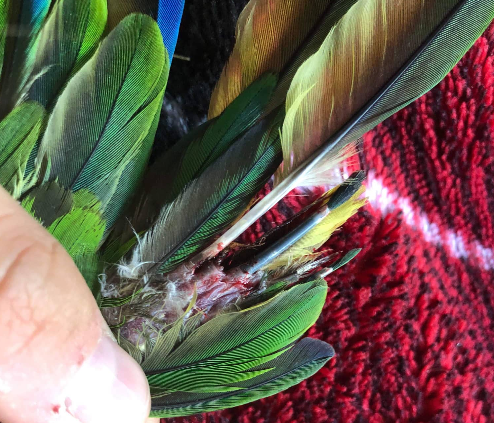
This image clearly illustrates how a bird’s incipient flight feathers are exposed and unsupported due to a wing clip. In this case, one became damaged and began to bleed while the bird was flapping. Fully flighted birds with unaltered feathers experience this only very, very rarely. Credit: @bird_tails on Instagram and TikTok.
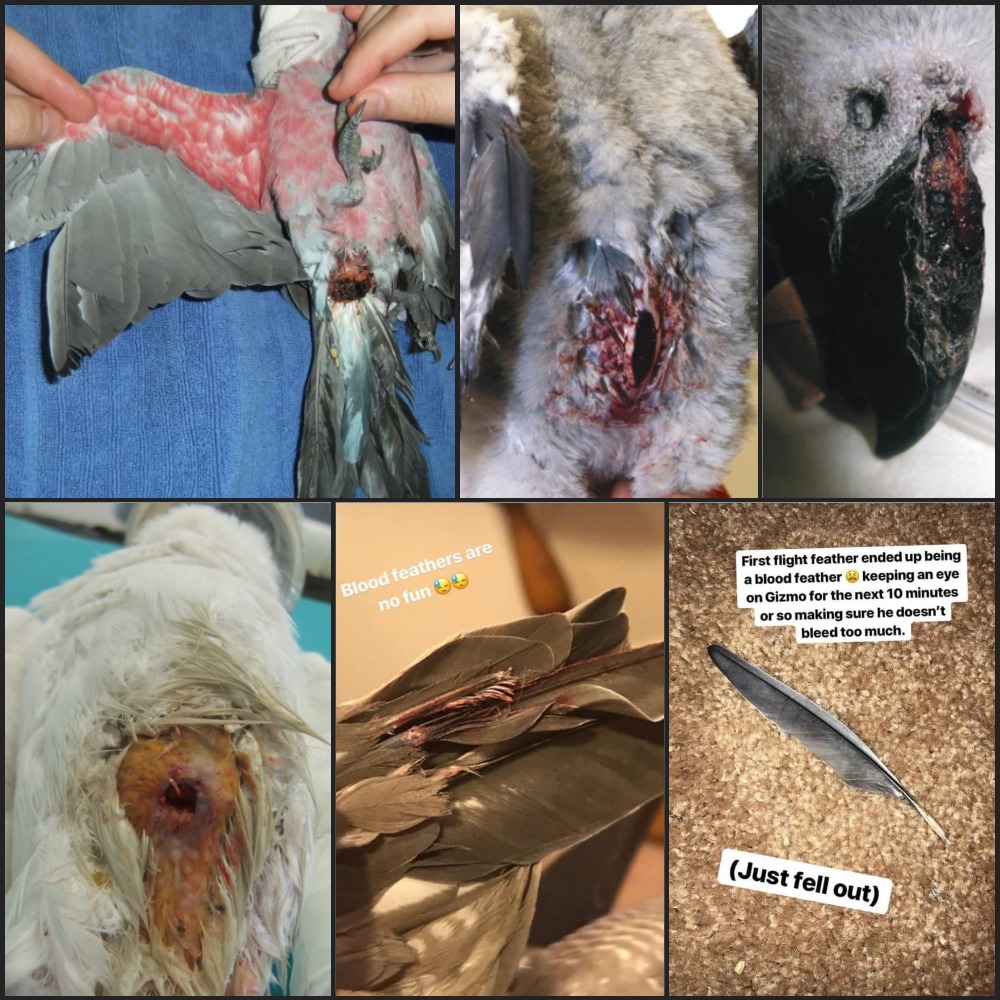
Top row and bottom left: These are all examples of injuries caused by birds falling with severe wing clips. (Source for top left and bottom left: see footnote 38. Source for top centre and top right: see footnote 36.) The bottom centre image shows a cockatiel’s injured blood feather due to the poor protection afforded by clipped feathers. The bottom right image shows that the same brand new flight feather has fallen out. (Credit for bottom centre and bottom right: @gizmo_the_tiel on Instagram.)
Dr. Adrian Gallagher, avian veterinarian, regularly performs a procedure called imping to restore flight to birds, especially those with severe or one-sided clips, by using donor feathers. “Ideally,” he says, “these days we recommend that we don’t trim their wings at all because we really want birds to exhibit as many natural behaviours as they can. We love birds because they can fly, so why do we want to take away their flight?”40 Sadly, severe wing clips are still all too common, and the one-sided clip is not yet extinct. Clipping just one wing used to be the recommended veterinary standard.41 Nowadays, the British Small Animal Veterinary Association’s manual on parrots states that “Wing clipping should not be used as a long-term management tool for the convenience of the owner”.42 Times change—slowly, but they change.
How can clipping affect a bird’s psychological well-being?
References
- Zheng, X., Wang, X., O'connor, J. and Zhou, Z., 2012. Insight into the early evolution of the avian sternum from juvenile enantiornithines. Nature Communications, 3, p.1116. https://www.nature.com/articles/ncomms2104?WT=
- Peng, S.J.L., Chang, F.C., Sheng-Ting, J.I. and Fei, A.C.Y., 2013. Welfare assessment of flight-restrained captive birds: effects of inhibition of locomotion. The Thai Journal of Veterinary Medicine, 43(2), p.235. https://www.researchgate.net/publication/287605561_Welfare_Assessment_of_Flight-restrained_Captive_Birds_Effects_of_Inhibition_of_Locomotion
- Brooks, N.E. and Myburgh, K.H., 2014. Skeletal muscle wasting with disuse atrophy is multi-dimensional: the response and interaction of myonuclei, satellite cells and signaling pathways. Frontiers in physiology, 5, p.99. https://www.frontiersin.org/articles/10.3389/fphys.2014.00099/full
- Steffl, M., Bohannon, R.W., Sontakova, L., Tufano, J.J., Shiells, K. and Holmerova, I., 2017. Relationship between sarcopenia and physical activity in older people: a systematic review and meta-analysis. Clinical interventions in aging, 12, p.835. https://www.ncbi.nlm.nih.gov/pmc/articles/PMC5441519/
- Bodine, S.C., 2013. Disuse-induced muscle wasting. The international journal of biochemistry & cell biology, 45(10), pp.2200-2208. https://www.ncbi.nlm.nih.gov/pmc/articles/PMC3856924/
- Orosz, S., 2016. Bird Vets Flock To Portland For ExoticsCon 2016. Lafeber Company. https://lafeber.com/pet-birds/bird-vets-flock-portland-exoticscon-2016/
- Bergmann, P., Body, J.J., Boonen, S., Boutsen, Y., Devogelaer, J.P., Goemaere, S., Kaufman, J., Reginster, J.Y. and Rozenberg, S., 2010. Loading and skeletal development and maintenance. Journal of osteoporosis, 2011. https://www.hindawi.com/journals/jos/2011/786752/
- Krautwald-Junghanns, M.E., Braun, S., Pees, M., Straub, J. and Valerius, H.P., 2004. Research on the anatomy and pathology of the psittacine heart. Journal of Avian Medicine and Surgery, 18(1), pp.2-12. https://www.jstor.org/stable/40236502
- Pees, M. and Krautwald-Junghanns, M.E., 2009. Cardiovascular physiology and diseases of pet birds. Veterinary Clinics of North America: Exotic Animal Practice, 12(1), pp.81-97. https://www.sciencedirect.com/science/article/abs/pii/S1094919408000583
- Bavelaar, F.J. and Beynen, A.C., 2004. Atherosclerosis in parrots. A review. Veterinary Quarterly, 26(2), pp.50-60. https://www.ncbi.nlm.nih.gov/pubmed/15230050
- Ratcliffe, H.L. and Cronin, M.T.I., 1958. Changing frequency of arteriosclerosis in mammals and birds at the philadelphia zoological garden: Review of autopsy records. Circulation, 18(1), pp.41-52. https://www.ahajournals.org/doi/pdf/10.1161/01.CIR.18.1.41
- Strunk, A. and Wilson, G.H., 2003. Avian cardiology. The veterinary clinics of North America. Exotic animal practice, 6(1), pp.1-28. https://www.vetexotic.theclinics.com/article/S1094-9194(02)00031-2/pdf
- Harrison, G.J. and Lightfoot, T., 2005. Clinical Avian Medicine. Spix Publishing, p. 393. http://avianmedicine.net/wp-content/uploads/2013/03/12_cardiology.pdf
- Pollock, C., 2007 (updated 2012). Nutritional Management of Obesity in Birds. LafeberVet. https://lafeber.com/vet/obesity/
- Ritchie, B.W., Harrison, G.J., and Harrison, L.R., 1994. Avian Medicine: Principles and Application. Zoological Education Network, p. 526. http://avianmedicine.net/wp-content/uploads/2013/03/20.pdf
- Fabbrini, E., Sullivan, S. and Klein, S., 2010. Obesity and nonalcoholic fatty liver disease: biochemical, metabolic, and clinical implications. Hepatology, 51(2), pp.679-689. https://www.ncbi.nlm.nih.gov/pmc/articles/PMC3575093/
- Kovesdy, C.P., Furth, S.L., Zoccali, C. and World Kidney Day Steering Committee, 2017. Obesity and kidney disease: hidden consequences of the epidemic. https://www.ncbi.nlm.nih.gov/pmc/articles/PMC5433675/
- Datar, S.P. and Bhonde, R.R., 2011. Modeling chick to assess diabetes pathogenesis and treatment. The review of diabetic studies: RDS, 8(2), p.245. https://www.ncbi.nlm.nih.gov/pmc/articles/PMC3280009/
- Jiang, S.Z., Lu, W., Zong, X.F., Ruan, H.Y. and Liu, Y., 2016. Obesity and hypertension. Experimental and therapeutic medicine, 12(4), pp.2395-2399. https://www.ncbi.nlm.nih.gov/pmc/articles/PMC5038894/
- King, L.K., March, L. and Anandacoomarasamy, A., 2013. Obesity & osteoarthritis. The Indian journal of medical research, 138(2), p.185. https://www.ncbi.nlm.nih.gov/pmc/articles/PMC3788203/
- Sirois, M., 2015. Elsevier’s Veterinary Assisting Textbook. Elsevier Health Sciences, p. 394. https://books.google.com/books?id=VNpQCwAAQBAJ
- Ritchie, B.W., Harrison, G.J., and Harrison, L.R., 1994. Avian Medicine: Principles and Application. Zoological Education Network, p. 848. http://avianmedicine.net/wp-content/uploads/2013/03/20.pdf
- Egg Binding in Birds, n.d. Center for Avian and Exotic Medicine. https://avianandexoticvets.com/egg-binding-in-birds
- Ward, S., Bishop, C.M., Woakes, A.J. and Butler, P.J., 2002. Heart rate and the rate of oxygen consumption of flying and walking barnacle geese (Branta leucopsis) and bar-headed geese (Anser indicus). Journal of Experimental Biology, 205(21), pp.3347-3356. https://jeb.biologists.org/content/205/21/3347
- Jackson, B.E., Tobalske, B.W. and Dial, K.P., 2011. The broad range of contractile behaviour of the avian pectoralis: functional and evolutionary implications. Journal of Experimental Biology, 214(14), pp.2354-2361. https://jeb.biologists.org/content/214/14/2354
- Campbell, J.P. and Turner, J.E., 2018. Debunking the myth of exercise-induced immune suppression: redefining the impact of exercise on immunological health across the lifespan. Frontiers in immunology, 9, p.648. https://www.frontiersin.org/articles/10.3389/fimmu.2018.00648/full
- Kempermann, G., Fabel, K., Ehninger, D., Babu, H., Leal-Galicia, P., Garthe, A. and Wolf, S., 2010. Why and how physical activity promotes experience-induced brain plasticity. Frontiers in neuroscience, 4, p.189. https://www.frontiersin.org/articles/10.3389/fnins.2010.00189/full
- Sleiman, S.F., Henry, J., Al-Haddad, R., El Hayek, L., Haidar, E.A., Stringer, T., Ulja, D., Karuppagounder, S.S., Holson, E.B., Ratan, R.R. and Ninan, I., 2016. Exercise promotes the expression of brain derived neurotrophic factor (BDNF) through the action of the ketone body β-hydroxybutyrate. Elife, 5, p.e15092. https://www.ncbi.nlm.nih.gov/pmc/articles/PMC4915811/
- Liguori, I., Russo, G., Curcio, F., Bulli, G., Aran, L., Della-Morte, D., Gargiulo, G., Testa, G., Cacciatore, F., Bonaduce, D. and Abete, P., 2018. Oxidative stress, aging, and diseases. Clinical interventions in aging, 13, p.757. https://www.ncbi.nlm.nih.gov/pmc/articles/PMC5927356/
- Larcombe, S.D., Coffey, J.S., Bann, D., Alexander, L. and Arnold, K.E., 2010. Impacts of dietary antioxidants and flight training on post-exercise oxidative damage in adult parrots. Comparative Biochemistry and Physiology Part B: Biochemistry and Molecular Biology, 155(1), pp.49-53. https://www.sciencedirect.com/science/article/pii/S109649590900236X
- Larcombe, S.D., Tregaskes, C.A., Coffey, J., Stevenson, A.E., Alexander, L.G. and Arnold, K.E., 2015. Oxidative stress, activity behaviour and body mass in captive parrots. Conservation physiology, 3(1). https://academic.oup.com/conphys/article/3/1/cov045/2571266
- Simioni, C., Zauli, G., Martelli, A.M., Vitale, M., Sacchetti, G., Gonelli, A. and Neri, L.M., 2018. Oxidative stress: role of physical exercise and antioxidant nutraceuticals in adulthood and aging. Oncotarget, 9(24), p.17181. https://www.ncbi.nlm.nih.gov/pmc/articles/PMC5908316/
- Sullivan, T.N., Meyers, M.A. and Arzt, E., 2019. Scaling of bird wings and feathers for efficient flight. Science advances, 5(1), p.eaat4269. https://advances.sciencemag.org/content/5/1/eaat4269
- Bogin, B. and Varela-Silva, M.I., 2010. Leg length, body proportion, and health: a review with a note on beauty. International journal of environmental research and public health, 7(3), pp.1047-1075. https://www.ncbi.nlm.nih.gov/pmc/articles/PMC2872302/
- Orosz, S., 2016. Free Flight: Lessons from ExoticsCon. Lafeber Company. https://lafeber.com/pet-birds/free-flight-lessons-exoticscon/
- Speer, B., 2015. Current Therapy in Avian Medicine and Surgery. Elsevier Health Sciences, p. 700. https://books.google.com/books?id=LKY_CwAAQBAJ
- Wing Clipping & Trimming, n.d. Currumbin Valley Birds & Exotics Vet. http://www.currumbinvetservices.com.au/wing-clipping/
- Wing Clipping – Bird Vet Melbourne, n.d. Bird Vet Melbourne. http://www.birdclinic.net/bird13.htm
- Glendell, G., 2012. Should My Parrot’s Wings Be Clipped?. AFA Watchbird, 39(1), pp.37-42. https://journals.tdl.org/watchbird/index.php/watchbird/article/view/3296
- Totally Wild (S24 Ep. 114), 2018. Network Ten.
- Startup, C.M., 1967. The clipping and pinioning of wings. Journal of Small Animal Practice, 8(7), pp.401-403. https://onlinelibrary.wiley.com/doi/abs/10.1111/j.1748-5827.1967.tb04568.x
- Harcourt-Brown, N. and Chitty, J., 2005. BSAVA Manual of Psittacine Birds (No. Ed. 2). British Small Animal Veterinary Association, pp. 54-55. https://books.google.com/books/about/BSAVA_Manual_of_Psittacine_Birds.html?id=Y36FQgAACAAJ

